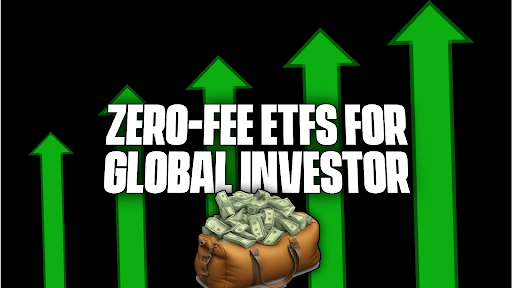🔍 INTRODUCTION
Let’s be honest—investing can feel overwhelming at first, especially when you’re worried about hidden fees eating into your gains. That’s where zero-fee ETFs come in. They’re a game-changer for beginners, students, or anyone trying to grow their money without watching it slowly drain from unnecessary charges.
In this blog post, we’ll explore what zero-fee ETFs are, where to buy them, and how to get started—step-by-step. Whether you’re in the U.S., India, Europe, or anywhere else in the world, this guide is for you.
✅ WHAT ARE ZERO-FEE ETFS, ANYWAY?
ETFs (Exchange-Traded Funds) are like baskets of different stocks or bonds that you can invest in—kind of like buying a pre-made fruit salad instead of shopping for each fruit individually.
A zero-fee ETF is simply an ETF with no annual expense ratio. Normally, most ETFs charge a small fee (around 0.03%–0.75%) annually to manage the fund. But with zero-fee ETFs, that number is zero.
So you get diversification and save money. Win-win!
🎯 Real Example:
Fidelity launched the Fidelity ZERO Total Market Index Fund (FZROX) and Fidelity ZERO International Index Fund (FZILX) with absolutely no management fees. That means every dollar you invest stays working for you.
✅ WHY ARE ZERO-FEE ETFS SO POPULAR NOW?
Simple—because no one wants to pay extra if they don’t have to. Especially if:
• You’re a student with limited savings
• A beginner trying to understand the market
• An international investor watching currency conversion fees
Zero-fee ETFs reduce friction and lower the cost of entry for people like you and me.
🤔 WHERE CAN GLOBAL INVESTORS BUY ZERO-FEE ETFS?
Great question! Here are some platforms that allow global investors to access low or zero-fee ETFs. But availability can vary depending on your country:
✅ 1. FIDELITY (Best for U.S. Investors)
Offers several zero-fee index funds and ETFs
• No minimum investment
• Commission-free trading
• Currently available mostly for U.S. residents, but some global investors use international brokerage services to access them
✅ 2. CHARLES SCHWAB
• Offers ultra-low-fee ETFs (almost zero)
• Commission-free trading on many ETFs
• Available in some international markets
✅ 3. INTERACTIVE BROKERS (IBKR)
• Supports users in 200+ countries
• Access to U.S. stock market and ETFs
• Offers many commission-free ETFs
Great for international investors looking for reliable access
✅ 4. Etoro
• User-friendly for beginners
• Offers fractional ETF investing
• Supports many countries globally
• Some ETFs have zero commissions
📝 Note: Some zero-fee ETFs might not be directly available in every country due to regulatory issues. In that case, look for ultra-low-cost ETFs with expense ratios under 0.05%.
✅ HOW TO START INVESTING IN ZERO-FEE ETFS (Beginner-Friendly Guide)
You don’t need a finance degree to start investing. Here’s how to begin step-by-step:
Step 1: Pick the Right Broker
Choose a platform that supports your country and offers access to U.S.-listed ETFs. If you're in Europe or Asia, Interactive Brokers is a solid choice.
Step 2: Open Your Investment Account
It’s usually free and takes less than 10 minutes online. Keep your passport or ID ready for verification.
Step 3: Fund Your Account
Most brokers accept bank transfers, credit/debit cards, or even e-wallets like Wise or Revolut. Try to start with at least $100–$500, but even $10 is a good start with fractional shares.
Step 4: Choose a Zero-Fee ETF
Look for ETFs like:
• FZROX – Total U.S. market
• FZILX – International stocks
• ITOT – Nearly zero-fee ETF from iShares
• SCHB – Schwab U.S. Broad Market ETF
Step 5: Start Investing
Click "Buy", choose the amount, and you’re in! Watch your portfolio grow over time.
🎯 Pro Tips for Beginners
💡 Start Small, Stay Consistent: Even $25/month adds up over time with compounding.
💡 Think Long-Term: ETFs work best when you let them grow over years.
💡 Reinvest Dividends: Turn your returns into more returns.
💡 Avoid Overtrading: Zero fees don’t mean you should buy/sell too often.
💡 Watch Out for Currency Fees: Use low-cost currency conversion services like Wise if investing in USD from another country.
✅ ARE ZERO-FEE ETFS REALLY SAFE?
Yes! Just like regular ETFs, zero-fee ETFs are regulated and managed by well-established financial firms like Fidelity. They simply waive their management fee to attract new investors. The underlying investments—like stocks and bonds—remain the same.
Still, always read the fund's prospectus and understand what you're investing in.
Conclusion
Zero-fee ETFs are perfect for global investors who want to start small, learn the ropes, and keep more of their returns. Whether you’re a college student, a freelancer, or someone planning for retirement—this could be the smartest first step in your investing journey.
Don’t let high fees stop you from building your future wealth. With the right broker and ETF, investing is easier than ever.
❓ FAQs – Zero-Fee ETFs for Beginners
Q1. Can I invest in zero-fee ETFs if I’m not in the U.S.?
Yes, but you may need to use global brokers like Interactive Brokers or eToro. Some ETFs may not be available in your country due to local regulations.
Q2. Are zero-fee ETFs really free?
Zero-fee means there are no management or fund fees, but you might still pay small costs like currency conversion or bid-ask spreads.
Q3. How much money do I need to start investing?
You can start with as little as $10–$50, depending on the broker. Many offer fractional shares, so you don’t need to buy a full ETF unit.
Q4. Which is better—zero-fee ETFs or mutual funds?
Zero-fee ETFs are usually more flexible, cheaper, and easier for beginners compared to mutual funds, especially if you want to DIY your investing.
Disclaimer:
This content is for informational purposes only and does not constitute financial advice. Always do your own research or consult a certified financial advisor before making investment decisions. Investments are subject to market risk, and past performance is not indicative of future results.

Comments
Post a Comment